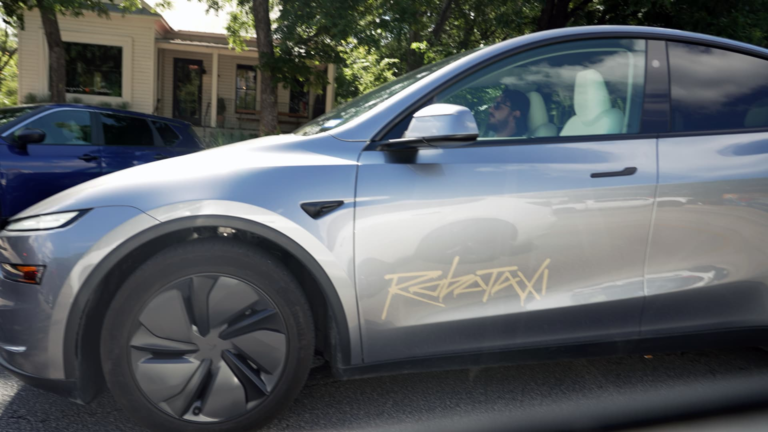Tesla’s June launch of its long-awaited “robotaxi” requires a lot of qualifiers: it was supervised, open only to a few invitees and included somewhere between 10-20 vehicles.
The stock jumped 8% the day after the launch, and some participants and observers called it a success. The shares have largely given back that gain since then.
“I thought it was extremely smooth. Everything we saw,” said Wedbush analyst Dan Ives. “Not just from a safety perspective. Maneuverability was way impressive. I thought actually even better than Waymo out of the gates. I thought going into it was going to be an eight out of 10. I think it’s a 10 out of 10 relative to our experience.”
Other experiences were less smooth: One vehicle drove on the wrong side of the road, one vehicle stopped in the middle of traffic, one braked suddenly on a 40 mph street and another vehicle dropped off a passenger in the middle of an intersection.
“What Tesla put out this past Sunday is not a robotaxi,” said analyst Gordon Johnson of GLJ Research in note published Thursday. “It is a robotaxi infant that requires constant supervision to stop it from injuring itself or others.”
Since 2016, CEO Elon Musk has been promising that Tesla vehicles were on the cusp of full autonomy.
Tesla’s Master Plan, Part Deux, envisioned a future where every Tesla owner would be able to “add your car to the Tesla shared fleet just by tapping a button on the Tesla phone app and have it generate income for you while you’re at work or on vacation, significantly offsetting and at times potentially exceeding the monthly loan or lease cost.”
He said in October of that year that all Tesla vehicles would have the hardware necessary for full self-driving.
In 2019, he said Tesla would have 1 million robotaxis on the road by 2020.
So far, none of these predictions have come true. And many researchers and rivals have disputed Musk’s claim that Teslas already have all the hardware needed for full autonomy.
The electric car maker is taking a very different path from every other major company working toward fully self-driving vehicles. It does not use radar or lidar — laser-based devices that map the environment around the vehicle.
Companies like Alphabet’s Waymo and Amazon‘s Zoox each use both radar and lidar. Tesla, in contrast, primarily uses cameras. Musk has said he thinks software can make up the difference.
“Inside the autonomous vehicle industry, I think the thing that’s both frustrating and just puzzling is that, you know, everyone seems to be on the same page,” said Ed Niedermeyer, a journalist who has covered Tesla for years and who wrote a book on the company. “You talk to almost any major expert and they’ll say, you know, what Tesla is doing is interesting. It’s pushing the technology forward in certain ways. Right? It’s like teaching a dog to drive. If you can teach a dog to drive a little ways, that’s super impressive. Does that mean you’re going to build a business around dogs driving taxis? No.”
The other key difference is Tesla has long been promoting what Niedermeyer calls a “general solution” to full self-driving. That means every Tesla will be able to drive itself under all circumstances anywhere in the world.
This is pretty much what Musk said in Tesla’s second Master Plan, “When true self-driving is approved by regulators, it will mean that you will be able to summon your Tesla from pretty much anywhere.”
This presents tremendous technical challenges.
“If your operating domain is the whole world, how do you ever get enough miles to know that you’ve covered everything that you’re ever going to see in all the conditions that exist out there in the world?” Niedermeyer said.
Everyone else is taking the Waymo route — deploying fleets of vehicles to a small contained area like parts of Austin, Texas, Phoenix and San Francisco.
The fact that Tesla chose to only deploy robotaxis in a section of Austin, rather than let them roam everywhere, is one reason why Niedermeyer said the company is kind of proving that Waymo is taking the more feasible approach.
“It’s funny because Tesla wants Austin to be the show, the performance that shows, ‘hey, like, we’re doing this, we can do driverless, right?'” he said. “But really what it’s showing is, well, Waymo kind of had it right all along.”
Musk still has fans and believers.
“Tesla is the future,” said Darko Protich, an Austin resident who CNBC spoke with at a local coffee shop.
Protich said he has owned a few Tesla vehicles and has ridden in similar autonomous vehicles from Waymo, which he said he grew to like after a bit of apprehension. He has also ridden in robotaxi-like cars in China, and has less confidence in those.
“They’re not as safe,” Protich said. “They’re smaller. But I believe in Teslas, honestly.”
Another fan is Michael Simon, from Buda, Texas.
“I just think it’s amazing what, what Elon is doing,” he said. “When I saw robotaxis were active, I was like, I want to ride.”
Neither Protich nor Simon had ridden in the initial launch models, but both said they were looking forward to the chance.
“Elon has made a huge investment in the Austin area, and if I were younger and still working, I would absolutely put in a resume for Tesla to try to go to work for them and be part of that exciting technology and the future,” Simon said.

